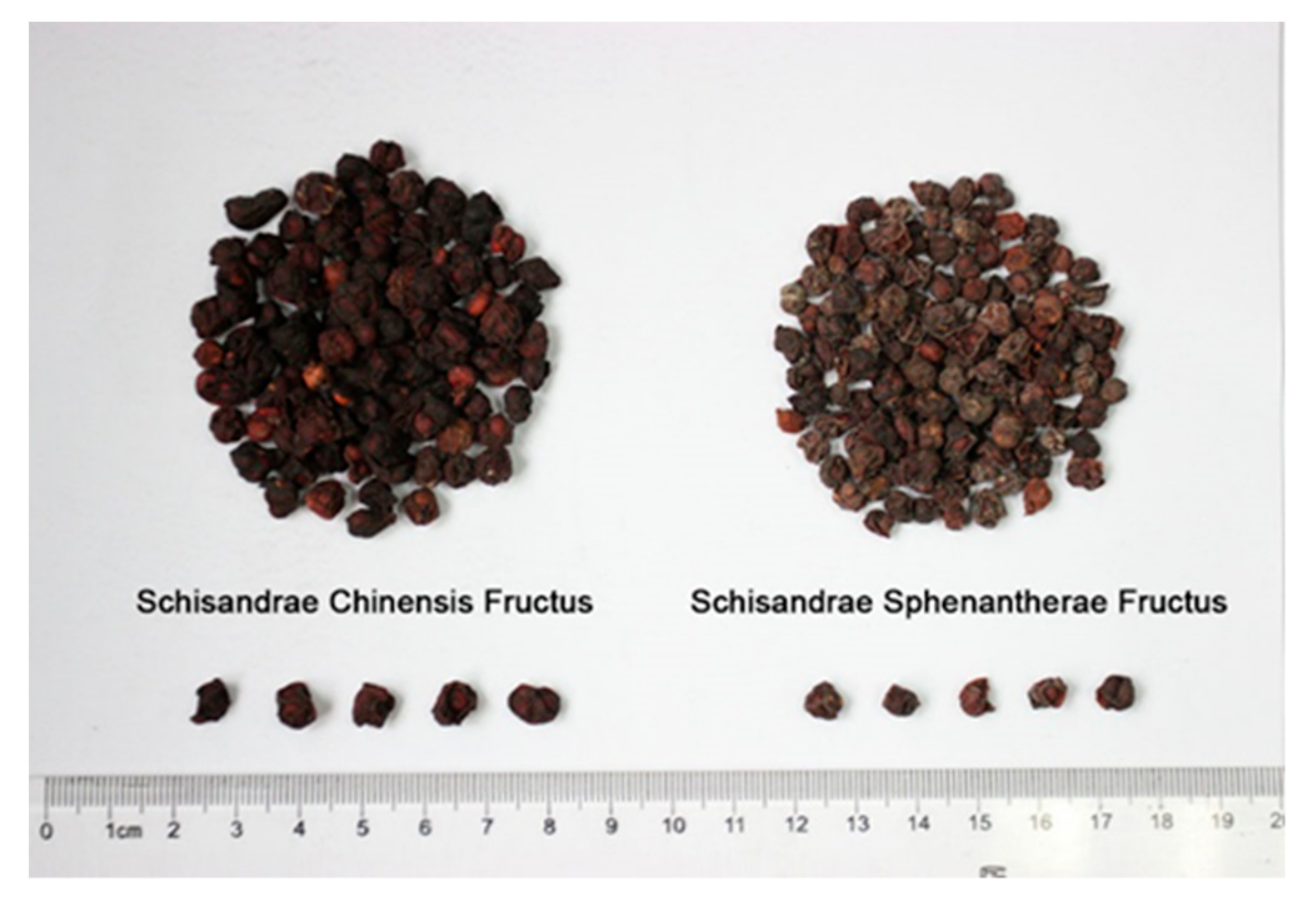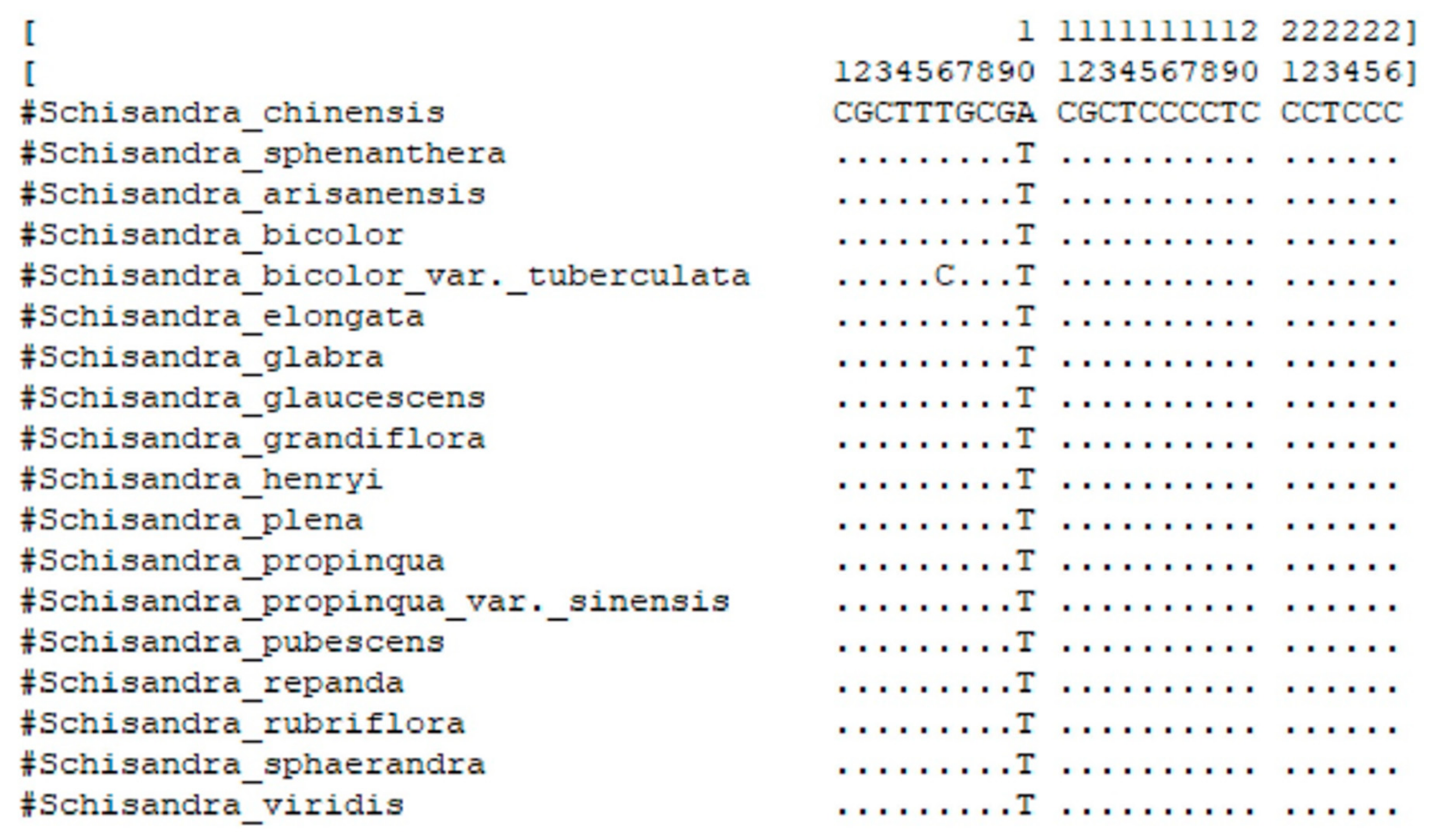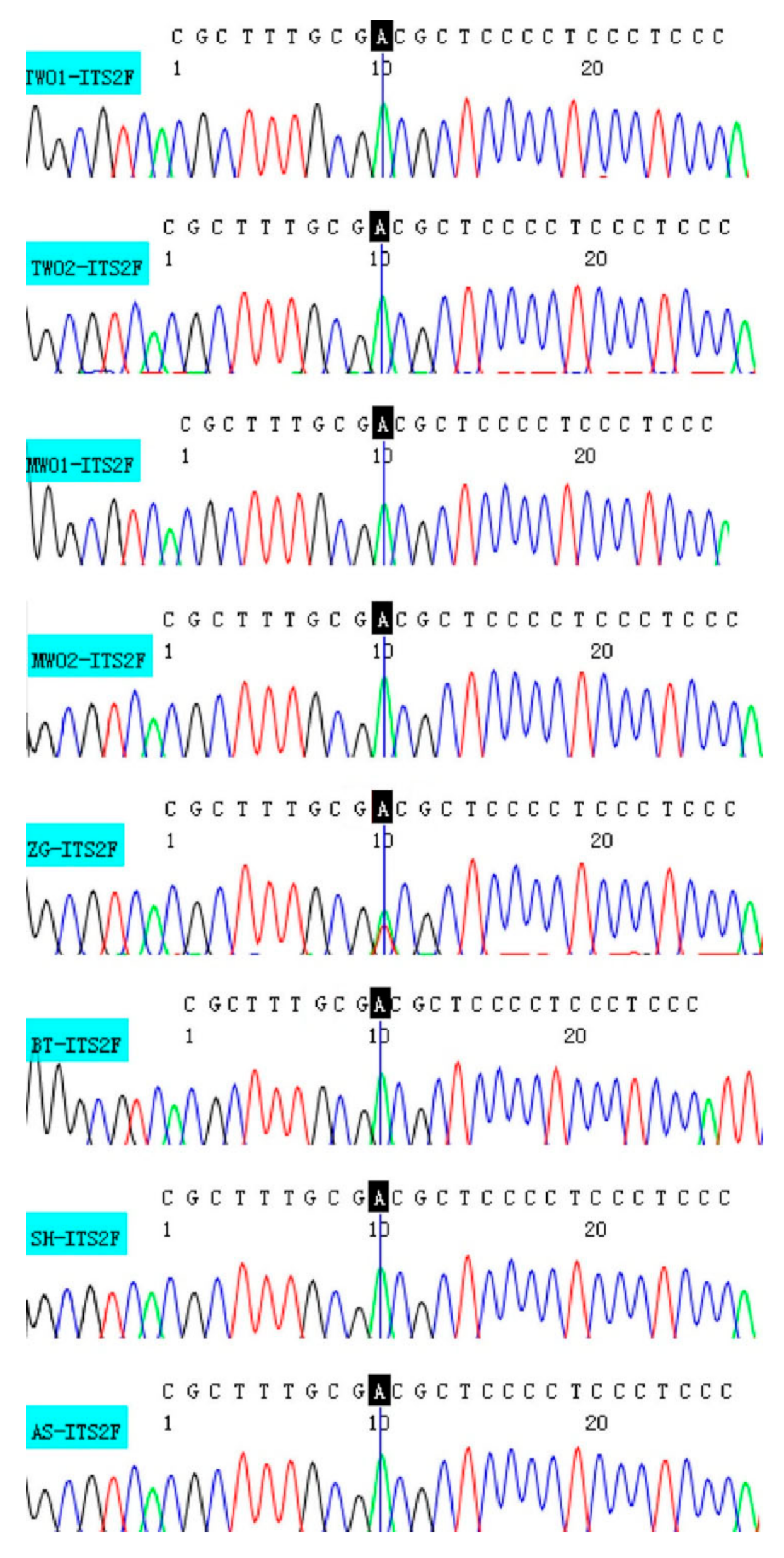Detecting Schisandrae Chinensis Fructus and Its Chinese Patent Medicines with a Nucleotide Signature
Abstract
1. Introduction
2. Materials and Methods
2.1. Sampling of the Materials
2.2. DNA Extraction, PCR Amplification, and Sequencing
2.2.1. Fruit, Leaf, and Seedling
2.2.2. Commercial Crude Drug Sample and Chinese Patent Medicine
2.3. Sequence Analysis
3. Results
3.1. Development of Nucleotide Signature for S. chinensis
3.2. Evaluation of the Nucleotide Signature
3.3. Identification of Commercial Samples
3.3.1. Commercial Crude Drug Samples
3.3.2. Chinese Patent Medicines
4. Discussion
4.1. The Necessity of Developing Nucleotide Signature for Chinese Patent Medicines
4.2. Nucleotide Signature Can Effectively Detect Wuweizi and Its Chinese Patent Medicines
4.3. Nucleotide Signature Is a Powerful Technique for Herbal Market Supervision
5. Conclusions
Supplementary Materials
Author Contributions
Funding
Conflicts of Interest
References
- Chinese Pharmacopoeia Commission. Pharmacopoeia of the People’s Republic of China, 1st ed.; Press of Chinese Medical Science and Technology: Beijing, China, 2015; pp. 66–67 and 244. [Google Scholar]
- Lu, Y.; Chen, D.-F. Analysis of Schisandra chinensis and Schisandra sphenanthera. J. Chromatogr. A. 2009, 1216, 1980–1990. [Google Scholar] [CrossRef]
- USSR Ministry of Health. The State Pharmacopoeia of the Union Soviet Socialist Republics, 10th ed.; USSR Ministry of Health: Moscow, Russia, 1966.
- Zhu, M.; Lin, K.F.; Yeung, R.Y.; Li, R.C. Evaluation of the protective effects of Schisandra chinensis on Phase I drug metabolism using a CCl4 intoxication model. J. Ethnopharmacol. 1999, 67, 61–68. [Google Scholar] [CrossRef]
- Pan, S.Y.; Dong, H.; Zhao, X.Y.; Xiang, C.J.; Fang, H.Y.; Fong, W.F.; Yu, Z.L.; Ko, K.M. Schisandrin B from Schisandra chinensis reduces hepatic lipid contents in hypercholesterolaemic mice. J. PharmPharmacol. 2008, 60, 399–403. [Google Scholar] [CrossRef]
- Cheng, N.; Ren, N.; Gao, H.; Lei, X.; Zheng, J.; Cao, W. Antioxidant and hepatoprotective effects of Schisandra chinensis pollen extract on CCl4-induced acute liver damage in mice. Food Chem. Toxicol. 2013, 55, 234–240. [Google Scholar] [CrossRef] [PubMed]
- Oh, S.Y.; Kim, Y.H.; Bae, D.S.; Um, B.H.; Pan, C.H.; Kim, C.Y.; Lee, H.J.; Lee, J.K. Anti-inflammatory effects of gomisin N, gomisin J, and schisandrin C isolated from the fruit of Schisandra chinensis. Biosci. Biotech. Bioch. 2010, 74, 285–291. [Google Scholar] [CrossRef]
- Guo, L.Y.; Hung, T.M.; Bae, K.H.; Shin, E.M.; Zhou, H.Y.; Hong, Y.N.; Kang, S.S.; Kim, H.P.; Kim, Y.S. Anti-inflammatory effects of schisandrin isolated from the fruit of Schisandra chinensis Baill. Eur. J. Pharmacol. 2008, 591, 293–299. [Google Scholar] [CrossRef]
- Hwang, D.; Shin, S.Y.; Lee, Y.; Hyun, J.; Yong, Y.; Park, J.C.; Lee, Y.H.; Lim, Y. A compound isolated from Schisandra chinensis induces apoptosis. Bioorg. Med. Chem. Lett. 2011, 21, 6054–6057. [Google Scholar] [CrossRef]
- Kim, S.J.; Min, H.Y.; Lee, E.J.; Kim, Y.S.; Bae, K.; Kang, S.S.; Lee, S.K. Growth inhibition and cell cycle arrest in the G0/G1 by schizandrin, a dibenzocyclooctadiene lignan isolated from Schisandra chinensis, on T47D human breast cancer cells. Phytother. Res. 2010, 24, 193–197. [Google Scholar] [CrossRef] [PubMed]
- Zhang, S.N; Wu, S.X. Advances in chemical and pharmacological effects of volatile oil from Schisandra fruits. J. Chin. Med. Mater. 2007, 30, 118–120. [Google Scholar]
- Hu, Y.J.; Chen, J.Z.; Ye, L. The study evolvement of chemic components and diferentiation methods between Schisandra chinensis and Schisandra sphenanthera. Res. Pr. Chin. Med. 2008, 22, 59–62. [Google Scholar]
- Jiang, P.; Lu, Y.; Chen, D. Authentication of Schisandra chinensis and Schisandra sphenanthera in Chinese patent medicines. J. Pharmaceut. Biomed. 2016, 131, 263–271. [Google Scholar] [CrossRef]
- Zhu, M.; Cao, Y.; Fan, G. Microwave-Assisted Extraction and Fingerprint Studies of Schisandra Chinensis (Turcz.) by High Performance Liquid Chromatography. J. Liq. Chromatogr. R. T. 2007, 30, 123–133. [Google Scholar] [CrossRef]
- Wei, H.; Sun, L.; Tai, Z.; Gao, S.; Xu, W.; Chen, W. A simple and sensitive HPLC method for the simultaneous determination of eight bioactive components and fingerprint analysis of Schisandra sphenanthera. Anal. Chim. Acta 2010, 662, 97–104. [Google Scholar] [CrossRef] [PubMed]
- Sun, Y.; Wen, X.; Huang, H. Population genetic differentiation of Schisandra chinensis and Schisandra sphenanthera as revealed by ISSR analysis. Biochem. Syst. Ecol. 2010, 38, 257–263. [Google Scholar] [CrossRef]
- Lee, Y.M.; Moon, B.C.; Ji, Y.; Seo, H.S.; Kim, H.K. Development of RAPD-Derived SCAR Markers and Multiplex-PCR for Authentication of the Schisandrae Fructus. Korean J. Med. Crop Sci. 2013, 21, 165–173. [Google Scholar] [CrossRef]
- Hebert, P.D.; Cywinska, A.; Ball, S.L.; Dewaard, J.R. Biological identifications through DNA barcodes. P. Roy. Soc. B Biol. Sci. 2003, 270, 313–321. [Google Scholar] [CrossRef]
- Zhao, S.; Chen, X.; Song, J.; Pang, X.; Chen, S. Internal transcribed spacer 2 barcode: A good tool for identifying Acanthopanacis cortex. Front. Plant Sci. 2015, 6, 840. [Google Scholar] [CrossRef]
- Guo, M.; Ren, L.; Pang, X. Inspecting the True Identity of Herbal Materials from Cynanchum Using ITS2 Barcode. Front. Plant Sci. 2017, 8, 1945. [Google Scholar] [CrossRef] [PubMed]
- Li, X.-k.; Wang, B.; Han, R.-C.; Zheng, Y.-C.; Yin, H.-b.Y.; Xu, L.; Zhang, J.-K.; Xu, B.-l. Identification of medicinal plant Schisandra chinensis using a potential DNA barcode ITS2. Acta Soc. Bot. Pol. 2013, 82, 283–288. [Google Scholar] [CrossRef]
- Little, D.P. A DNA mini-barcode for land plants. Mol. Ecol. Resour. 2014, 14, 437–446. [Google Scholar] [CrossRef] [PubMed]
- Lo, Y.T.; Li, M.; Shaw, P.C. Identification of constituent herbs in ginseng decoctions by DNA markers. Chin. Med. 2015, 10, 1. [Google Scholar] [CrossRef]
- Yuan, Q.J.; Zhang, B.; Jiang, D.; Zhang, W.J.; Lin, T.Y.; Wang, N.H.; Chiou, S.J.; Huang, L.Q. Identification of species and materia medica within Angelica L. (Umbelliferae) based on phylogeny inferred from DNA barcodes. Mol. Ecol. Resour. 2015, 15, 358–371. [Google Scholar] [CrossRef]
- Meusnier, I.; Singer, G.A.C.; Landry, J.-F.; Hickey, D.A.; Hebert, P.D.N.; Hajibabaei, M. A universal DNA mini-barcode for biodiversity analysis. BMC Genomics 2008, 9, 214. [Google Scholar] [CrossRef]
- Little, D.P. Authentication of Ginkgo biloba herbal dietary supplements using DNA barcoding. Genome 2014, 57, 513–516. [Google Scholar] [CrossRef]
- Särkinen, T.; Staats, M.; Richardson, J.E.; Cowan, R.S.; Bakker, F.T. How to open the treasure chest? Optimising DNA extraction from herbarium specimens. PloS ONE 2012, 7(8), e43808. [Google Scholar] [CrossRef]
- Gibbs, A.J.; Armstrong, J.S.; Gibbs, M.J. A type of nucleotide motif that distinguishes tobamovirus species more efficiently than nucleotide signatures. Arch. Virol. 2003, 149, 1941–1954. [Google Scholar] [CrossRef]
- Ng, B.L.N.; Omarzuki, M.; Lau, G.S.K.; Pannell, C.M.; Yeo, T.C. A Nucleotide Signature for Identification of Aglaia stellatopilosa Pannell. Mol. Biotechnol. 2014, 56, 671–679. [Google Scholar] [CrossRef]
- Liu, Y.; Wang, X.; Wang, L.; Chen, X.; Pang, X.; Han, J. A Nucleotide Signature for the Identification of American Ginseng and Its Products. Front. Plant Sci. 2016, 7, 319. [Google Scholar] [CrossRef]
- Gao, Z.; Liu, Y.; Wang, X.; Song, J.; Chen, S.; Ragupathy, S.; Han, J.; Newmaster, S.G. Derivative Technology of DNA Barcoding (Nucleotide Signature and SNP Double Peak Methods) Detects Adulterants and Substitution in Chinese Patent Medicines. Sci. Rep. 2017, 7, 5858. [Google Scholar] [CrossRef]
- Wang, X.; Liu, Y.; Wang, L.; Han, J.; Chen, S. A Nucleotide Signature for the Identification of Angelicae Sinensis Radix (Danggui) and Its Products. Sci. Rep. 2016, 6, 34940. [Google Scholar] [CrossRef]
- Chen, S.; Yao, H.; Han, J.; Liu, C.; Song, J.; Shi, L.; Zhu, Y.; Ma, X.; Gao, T.; Pang, X.; et al. Validation of the ITS2 region as a novel DNA barcode for identifying medicinal plant species. PloS ONE 2010, 5, e8613. [Google Scholar] [CrossRef] [PubMed]
- Keller, A.; Schleicher, T.; Schultz, J.; Muller, T.; Dandekar, T.; Wolf, M. 5.8 S-28S rRNA interaction and HMM-based ITS2 annotation. Gene 2009, 430, 50–57. [Google Scholar] [CrossRef]
- Tamura, K.; Peterson, D.; Peterson, N.; Stecher, G.; Nei, M.; Kumar, S. MEGA5: Molecular evolutionary genetics analysis using maximum likelihood, evolutionary distance, and maximum parsimony methods. Mol. Biol. Evol. 2011, 28, 2731–2739. [Google Scholar] [CrossRef]
- Flora of China Editorial Committee. Flora of China; Press of Science and Missouri Botanical Garden: Beijing, China, 2008; Volume 7, pp. 41–47. [Google Scholar]
- Chen, X.; Liao, B.; Song, J.; Pang, X.; Han, J.; Chen, S. A fast SNP identification and analysis of intraspecific variation in the medicinal Panax species based on DNA barcoding. Gene 2013, 530, 39–43. [Google Scholar] [CrossRef] [PubMed]
- Ruhsam, M.; Hollingsworth, P.M. Authentication of eleutherococcus and rhodiola herbal supplement products in the United Kingdom. J. Pharmaceut. Biomed. 2018, 149, 403–409. [Google Scholar] [CrossRef] [PubMed]
- Han, J.; Pang, X.; Liao, B.; Yao, H.; Song, J.; Chen, S. An authenticity survey of herbal medicines from markets in China using DNA barcoding. Sci. Rep. 2016, 6, 18723. [Google Scholar] [CrossRef] [PubMed]




| Voucher No. | Collection Location | Genuine |
|---|---|---|
| DL01 | Dalian, Liaoning | Yes |
| DL02 | Dalian, Liaoning | Yes |
| BJ01 | Beijing | No |
| BJ02 | Beijing | Yes |
| XA01 | Xian, Shanxi | Yes |
| XA02 | Xian, Shanxi | Yes |
| WN01 | Weinan, Shanxi | No |
| NJ01 | Nanjing, Jiangsu | No |
| CZ01 | Changzhi, Shanxi | Yes |
| CZ02 | Changzhi, Shanxi | No |
| CZ03 | Changzhi, Shanxi | Yes |
| CZ04 | Changzhi, Shanxi | No |
| CZ05 | Changzhi, Shanxi | No |
| CZ06 | Changzhi, Shanxi | No |
| CZ07 | Changzhi, Shanxi | No |
| OL01 | online store (Aomiao) | Yes |
| OL02 | online store (Caobenyunnan) | Yes |
| CD01 | Chengdu, Sichuan | Yes |
| CD02 | Chengdu, Sichuan | Yes |
| BZ01 | Bozhou, Anhui | Yes |
| BZ02 | Bozhou, Anhui | Yes |
| BZ03 | Bozhou, Anhui | Yes |
| BZ04 | Bozhou, Anhui | Yes |
| AG01 | Anguo, Hebei | Yes |
| TH01 | Tonghua, Jilin | Yes |
| TH02 | Tonghua, Jilin | Yes |
| LC01 | Lincun, Jilin | Yes |
| Voucher No. | Samples | Listed Ingredients on Label | Collection Location | Genuine |
|---|---|---|---|---|
| TW01 | Tianwang Buxin Pills | Schisandrae Chinensis Fructus, Salviae Miltiorrhizae Radix Et Rhizoma, Angelicae Sinensis Radix, Acori Tatarinowii Rhizoma, Codonopsis Radix, Poria, Ophiopogonis Radix, Asparagi Radix, Rehmanniae Radix, Scrophulariae Radix, Polygalae Radix, Ziziphi Spinosae Semen, Platycladi Semen, Platycodonis Radix, Glycyrrhizae Radix Et Rhizoma, Cinnabaris | Beijing store | Yes |
| TW02 | Tianwang Buxin Pills | Schisandrae Chinensis Fructus, Salviae Miltiorrhizae Radix Et Rhizoma, Angelicae Sinensis Radix, Acori Tatarinowii Rhizoma, Codonopsis Radix, Poria, Ophiopogonis Radix, Asparagi Radix, Rehmanniae Radix, Scrophulariae Radix, Polygalae Radix, Ziziphi Spinosae Semen, Platycladi Semen, Platycodonis Radix, Glycyrrhizae Radix Et Rhizoma, Cinnabaris | online shop | Yes |
| MW01 | Maiwei Dihuang Pills | Schisandrae Chinensis Fructus, Ophiopogonis Radix, Rehmanniae Radix Praeparata, Corni fructus, Moutan Cortex, Dioscoreae Rhizoma, Poria, Alismatis Rhizoma | Beijing store | Yes |
| MW02 | Maiwei Dihuang Pills | Schisandrae Chinensis Fructus, Ophiopogonis Radix, Rehmanniae Radix Praeparata, Corni fructus, Moutan Cortex, Dioscoreae Rhizoma, Poria, Alismatis Rhizoma | online shop | Yes |
| ZG | Zengguang Tablets | Schisandrae Chinensis Fructus, Codonopsis Radix, Acori Tatarinowii Rhizoma, Poria, Alismatis Rhizoma, Ophiopogonis Radix, Lycii Fructus, Angelicae Sinensis Radix, Moutan Cortex, Polygalae Radix | online shop | No |
| BT | Bantu Pills | Schisandrae Chinensis Fructus, Rehmanniae Radix, Rehmanniae Radix Praeparata, Polygoni Multiflori Radix Praeparata, Angelicae Sinensis Radix, Salviae Miltiorrhizae Radix Et Rhizoma, Paeoniae Radix Alba, Notopterygii Rhizoma Et Radix, Chaenomelis Fructus | online shop | Yes |
| SH | Shihu Yeguang Pills | Schisandrae Chinensis Fructus, Dendrobii Caulis, Ginseng Radix Et Rhizoma, Dioscoreae Rhizoma, Poria, Glycyrrhizae Radix Et Rhizoma, Cistanches Herba, Lycii Fructus, Cuscutae Semen, Rehmanniae Radix, Rehmanniae Radix Praeparata, Asparagi Radix, Ophiopogonis Radix, Armeniacae Semen Amarum, Saposhnikoviae Radix, Chuanxiong Rhizoma, Aurantii Fructus, Coptidis Rhizoma, Achyranthis Bidentatae Radix, Chrysanthemi Flos, Tribuli Fructus, Celosiae Semen, Cassiae Semen, Bubali Cornu, Saigae Tataricae Cornu | online shop | Yes |
| AS | Anshen Capsules | Schisandrae Chinensis Fructus, Ziziphispinosaesemen, Chuanxiong Rhizoma, Anemarrhenae Rhizoma, Ophiopogonis Radix, Polygoni Multiflori Radix Praeparata, Salviae Miltiorrhizae Radix Et Rhizoma, Poria | online shop | Yes |
| Source Species of Nucleotide Signature | Blast Result in NCBI | Number of the Species | Max Score | Total Score | Query Cover | E Value | Per. Ident |
|---|---|---|---|---|---|---|---|
| Schisandra chinensis | Schisandra chinensis | 39 | 52.0 | 52.0 | 100% | 0.0003 | 100% |
| Schisandra sphenanthera | 1 | 44.1 | 44.1 | 100% | 0.065 | 96.15% | |
| Kadsura heteroclite | 1 | 44.1 | 44.1 | 100% | 0.065 | 96.15% | |
| Kadsura interior | 13 | 44.1 | 44.1 | 100% | 0.065 | 96.15% | |
| Schisandra sphaerandra | 2 | 44.1 | 44.1 | 100% | 0.065 | 96.15% | |
| Schisandra henryi | 2 | 44.1 | 44.1 | 100% | 0.065 | 96.15% | |
| Schisandra rubriflora | 4 | 44.1 | 44.1 | 100% | 0.065 | 96.15% | |
| Schisandra propinqua | 2 | 44.1 | 44.1 | 100% | 0.065 | 96.15% | |
| Schisandra henryi | 3 | 44.1 | 44.1 | 100% | 0.065 | 96.15% | |
| Kadsura longipedunculata | 27 | 44.1 | 44.1 | 100% | 0.065 | 96.15% | |
| Kadsura heteroclita | 6 | 44.1 | 44.1 | 100% | 0.065 | 96.15% |
© 2019 by the authors. Licensee MDPI, Basel, Switzerland. This article is an open access article distributed under the terms and conditions of the Creative Commons Attribution (CC BY) license (http://creativecommons.org/licenses/by/4.0/).
Share and Cite
Jiang, W.; Ren, L.; Guo, M.; Mantri, N.; Zhao, S.; Pang, X. Detecting Schisandrae Chinensis Fructus and Its Chinese Patent Medicines with a Nucleotide Signature. Genes 2019, 10, 397. https://doi.org/10.3390/genes10050397
Jiang W, Ren L, Guo M, Mantri N, Zhao S, Pang X. Detecting Schisandrae Chinensis Fructus and Its Chinese Patent Medicines with a Nucleotide Signature. Genes. 2019; 10(5):397. https://doi.org/10.3390/genes10050397
Chicago/Turabian StyleJiang, Wenjun, Li Ren, Mengyue Guo, Nitin Mantri, Sha Zhao, and Xiaohui Pang. 2019. "Detecting Schisandrae Chinensis Fructus and Its Chinese Patent Medicines with a Nucleotide Signature" Genes 10, no. 5: 397. https://doi.org/10.3390/genes10050397
APA StyleJiang, W., Ren, L., Guo, M., Mantri, N., Zhao, S., & Pang, X. (2019). Detecting Schisandrae Chinensis Fructus and Its Chinese Patent Medicines with a Nucleotide Signature. Genes, 10(5), 397. https://doi.org/10.3390/genes10050397





